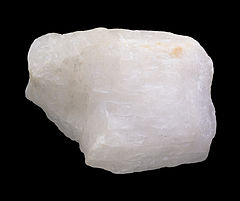Cryolite
| Cryolite | |
|---|---|

Cryolite from Ivigtut Greenland
|
|
| General | |
| Category | Halide Mineral |
|
Formula (repeating unit) |
Na3•AlF6 |
| Strunz classification | 3.CB.15 |
| Dana classification | 11.6.1.1 |
| Crystal system | Monoclinic |
| Crystal class | Prismatic (2/m) (same H-M symbol) |
| Space group | P21/n |
| Unit cell | a = 7.7564(3) Å, b = 5.5959(2) Å, c = 5.4024(2) Å; β = 90.18°; Z = 2 |
| Identification | |
| Formula mass | 209.9 g mol−1 |
| Color | Colorless to white, also brownish, reddish and rarely black |
| Crystal habit | Usually massive, coarsely granular. The rare crystals are equant and pseudocubic |
| Twinning | Very common, often repeated or polysynthetic with simultaneous occurrence of several twin laws |
| Cleavage | None observed |
| Fracture | Uneven |
| Tenacity | Brittle |
| Mohs scale hardness | 2.5 to 3 |
| Luster | Vitreous to greasy, pearly on {001} |
| Streak | White |
| Diaphaneity | Transparent to translucent |
| Specific gravity | 2.95 to 3.0. |
| Optical properties | Biaxial (+) |
| Refractive index | nα = 1.3385–1.339, nβ = 1.3389–1.339, nγ = 1.3396–1.34 |
| Birefringence | δ = 0.001 |
| 2V angle | 43° |
| Dispersion | r < v |
| Melting point | 1012 °C |
| Solubility | Soluble in AlCl3 solution, soluble in H2SO4 with the evolution of HF, which is poisonous. Insoluble in water. |
| Other characteristics | Weakly thermoluminescent. Small clear fragments become nearly invisible when placed in water, since its refractive index is close to that of water. May fluoresce intense yellow under SWUV, with yellow phosphorescence, and pale yellow phosphorescence under LWUV. Not radioactive. |
| References | |
Cryolite (Na3AlF6, sodium hexafluoroaluminate) is an uncommon mineral identified with the once large deposit at Ivigtût on the west coast of Greenland, depleted by 1987.
It was historically used as an ore of aluminium and later in the electrolytic processing of the aluminium-rich oxide ore bauxite (itself a combination of aluminium oxide minerals such as gibbsite, boehmite and diaspore). The difficulty of separating aluminium from oxygen in the oxide ores was overcome by the use of cryolite as a flux to dissolve the oxide mineral(s). Pure cryolite itself melts at 1012 °C (1285 K), and it can dissolve the aluminium oxides sufficiently well to allow easy extraction of the aluminium by electrolysis. Substantial energy is still needed for both heating the materials and the electrolysis, but it is much more energy-efficient than melting the oxides themselves. As natural cryolite is too rare to be used for this purpose, synthetic sodium aluminium fluoride is produced from the common mineral fluorite.
Cryolite occurs as glassy, colorless, white-reddish to gray-black prismatic monoclinic crystals. It has a Mohs hardness of 2.5 to 3 and a specific gravity of about 2.95 to 3.0. It is translucent to transparent with a very low refractive index of about 1.34, which is very close to that of water; thus if immersed in water, cryolite becomes essentially invisible.
...
Wikipedia
